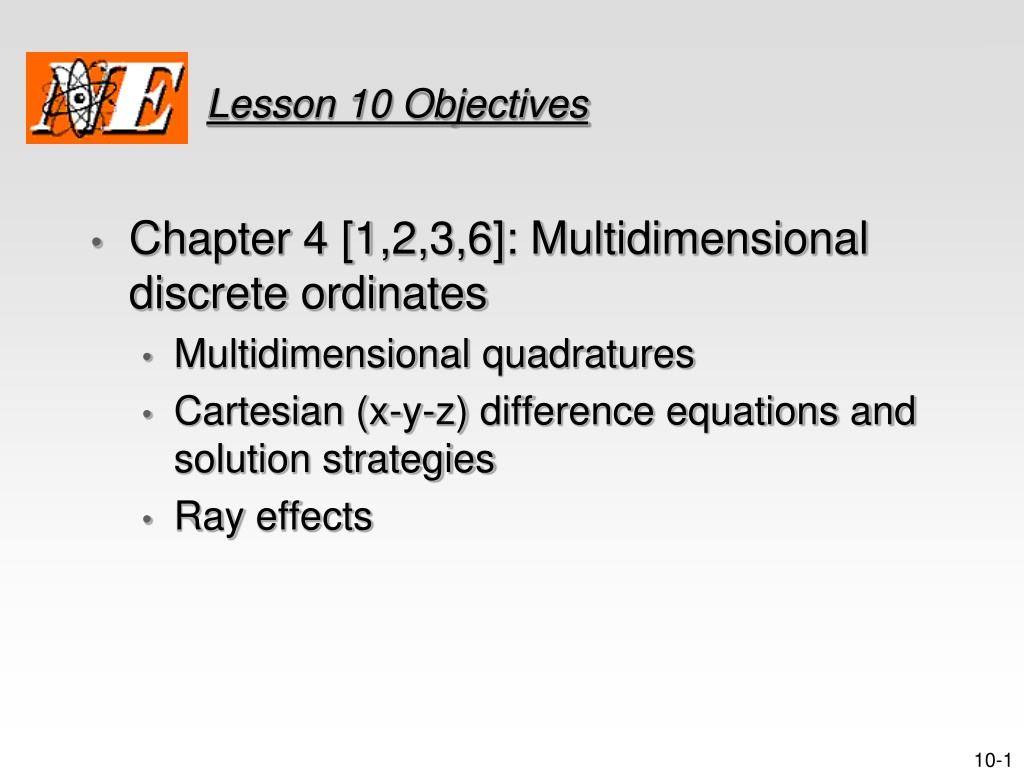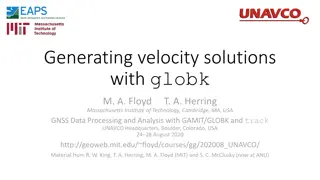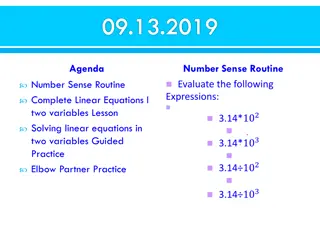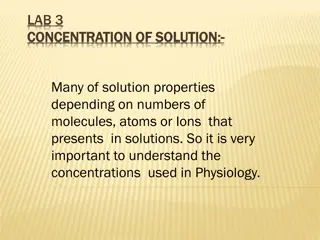Understanding MultiD Quadratures: Strategies and Solutions
Explore the concept of multidimensional discrete ordinates and quadratures in Cartesian coordinates, along with differences in solution strategies. Learn about the octants in unit directional sphere and the relationships between geometries and octants. Discover how to handle directional flux dependence with quadratures, reflection symmetry in quadratures, and the layout of quadratures in shielding problems. Dive into 3D quadratures and Level Symmetric Quadratures for a comprehensive understanding of the topic.
Uploaded on Oct 09, 2024 | 0 Views
Download Presentation

Please find below an Image/Link to download the presentation.
The content on the website is provided AS IS for your information and personal use only. It may not be sold, licensed, or shared on other websites without obtaining consent from the author. Download presentation by click this link. If you encounter any issues during the download, it is possible that the publisher has removed the file from their server.
E N D
Presentation Transcript
Lesson 10 Objectives Chapter 4 [1,2,3,6]: Multidimensional discrete ordinates Multidimensional quadratures Cartesian (x-y-z) difference equations and solution strategies Ray effects 10-1
MultiD quadratures In contrast to the one direction cosine we considered in Chapter 3, multidimensional D.O. use all 3: ; = = x = ; y z + + = 2 2 2 1 In terms of the eight octants of unit directional sphere: Octant 1 + 2 - 3 - 4 + 5 + 6 - 7 - 8 + + + - - + + - - + + + + - - - - 10-2
MultiD quadratures (2) We have the following relationships between geometry type and octants that must be calculated: Geometry Unique octants Reason ) = ( ( ) 1,2 ( only) 1D slab/spherical , , , , 1,2 ( & ) 1D cylindrical (same) ) = ( ( ) 1,2,3,4( & ) 2D geometries , , , , All 8 ( , , ) 3D geometries No symmetry 10-3
MultiD quadratures (3) Note that 1D cylindrical has an angular dependence like 2D because there is no rotational symmetry about the (one) spatial axis Again, we will be handling the directional flux dependence with a QUADRATURE: Calculating the angular flux only in particular directions and find the flux moments as weighted sums of these discrete ordinates : ( ) ( r n = = = , ) r n ( ) , ( , , ) ( ) ( ) ( ) n n n n N = ( ) ( , ) ( ) r d r w r n n 1 n 4 10-4
MultiD quadratures (4) Let s see how quadratures are laid out. First of all, we will assume the quadrature has reflection symmetry If Octant 1 has a direction , then: Octant 2 has the direction Octant 3 has the direction , etc. This is NOT required, but it gives us all the angles needed for reflection B.C. s and keeps things balanced It is COMMON for shielding problems to use biased quadratures that have more quadrature directions pointing in a direction of interest ( ) ) , ) , , , , ( ( , 10-5
MultiD quadratures (5) 3D quadrature S? 10-6
MultiD quadratures (5) The normal way of laying out quadratures is the Level Symmetric Quadratures: Note the and levels (the -levels are there, too) S8 quadrature Note that the -directions are not drawn, but you should be able to see them Be sure to keep the confusing subscripts straight (I started over with 1 even though we would normally call it 5). 10-7
MultiD quadratures (6) For Level Symmetric Quadratures (LSQ), the symmetry is extended to include 90 degree rotations as well: = = 2 , 1 = , ,..., / 2 n N n n n Somewhat surprisingly, there is only ONE degree of freedom in determining a LSQ: Once you choose the value of the first level, 1, the rest of the quadrature falls out automatically. Let s see why. Assuming that we have a direction that comprises the three levels i, j, and k, we must have: 2 2 2 + + = 1 i j k 10-8
MultiD quadratures (7) The key thing to see is that if we stay on a given - level symmetry and increase the mu-level by one, then the eta-level has to decrease by one: 2 1 1 + + + j i 2 2 = 1 k If we subtract: 2 2 2 + + = 1 i j k we get: = 2 2 2 2 + 1 1 i i j j But, since the mu, eta, and xsi values are all the same: = = 2 2 2 2 C + 1 1 i i j j This means that the differences of the squares of consecutive levels must be some constant, C, that is constant for the quadrature 10-9
MultiD quadratures (8) So, if you know 1 and C, you know the others: C 1 2 + = 2 2 = + 2 2 2 = + 2 C C 3 2 1 ( )C 1 2 2 = + j 1 j Using the one real point we can count on: That the direction closest to the North Pole in our graph HAS to have the lowest , the lowest , and the HIGHEST , therefore: + + = 2 2 2 N 1 1 1 /2 10-10
MultiD quadratures (9) which can be translated into: + + = 2 2 1 1 1 /2 N N + + + = 2 2 2 ( 1) 1 C 1 1 1 2 ( ) 2 2 1 3 N 2 1 3 N 1 = = C 1 2 1 2 So, after picking a 1, we can find C from the above equation, then build the N/2 level values. With the level values, the actual quadrature comprises all combinations of i, j, and k such that + + j i 2 2 2 = 1 k 10-11
MultiD quadratures (10) The only quadrature this does not work for is S2, for which C is undefined. For this special case (one direction per quadrature), symmetry demands that: = = 1 1 1 From the required relation: 2 2 2 + + = 1 1 1 1 we can easily see that: = = = / 1 3 . 0 57735 1 1 1 Interestingly, this is the LARGEST that 1 can be since the formula for C is only non-negative if: 1 / 1 3 10-12
MultiD quadratures (11) Returning to the original octant drawing, we see that the upshot of all this is that the number of values in each eta-level decreases by 1 for each step we make: This also works vertically (for xsi-levels), although you cannot see it in the graph. (In looking at the graph, you should imagine that you looking down on point drawn on the first octant of a basketball, e.g., the lower left one is the HIGHEST one. Look at 10-6 again.) So, how many directions ARE there, total? 10-13
MultiD quadratures (12) Let s count them: There are N/2 directions for 1st eta-level There are (N-1)/2 directions for the 2nd eta-level. There is 1 direction for the (N/2)th eta-level. # of levels per octant N N + = 1. 2. 3. 4. = + -1)/2 ... 1 + + /2 ( 2) + N N /2( /2 1) ( N N = 2 8 For a 3D geometry (the whole basketball), there are 8 octants, so ( 8 8 + 2) N N = = + ( 2) # of levels for 3D N N For 2D (x,y) geometry, we have symmetry up and down, so there is no use calculating the down directions: ( 4 8 + + 2) ( 2) N N N N = = # of levels for 2D 2 10-14
MultiD quadratures (13) Once the directions are found, the weights are found with a 3 step process: All quadrant reflections are restrained to have the same weight: ( ) , , ( k j i w w , , ) i j k This means we only have to worry about the N(N+2)/8 values in the first quadrant. All permutations of the level subscript numbers have the same weight. , ) k etc. ( , , ) ( , , ) ( , , w w w i j k i k j j i The unique weights that remain are found by either: Correctly integrating as many 1D moments as possible (works up to about S20); or Associating an area of the unit sphere with each direction (maintaining symmetry) and using as the weight. 1. 2. 10-15
Find the equal weights Take this quadrature (what is its order?) and label with the indices: Now mark out the directions with the same weight 10-16
Find the equal weights (2) The unique weights that remain are found by: Finding the weights for each of the N/2 levels to correctly integrate the EVEN 1D moments to order 2(N-1). 1. 1 /2 1 2 N = = , 0,2,..., 2 d w N n n = 1 n 0 to the highest even moment that you can. Solving the linear algebra problem to find the unique weights for the multidimensional directions which will only have a solution for a particular value of 1. Repeat Steps 1 & 2, modifying 1 to get the NEXT even moment as well. 2. 3. They say this works up to about S20 Book only goes to S16 See Table 4-1 in text. 10-17
Cartesian difference equations The spatial differencing for (x,y) geometry is a straight-forward extension of what we did in slab. Integration of the continuous space equation over a rectangular cell: jy / 1 + 2 Cell ij jy / 1 2 ix ix / 1 / 1 + 2 2 gives us: 10-18
Cartesian difference equations (2) 1/2 + 1/2 + y x ( , ) x y x ( , ) x y x + + ( , ) x y ( , ) x y n n z dx dy n n t n 1/2 1/2 x y 1/2 + 1/2 + y x = ( , ) z dx dy S x y n 1/2 1/2 x y Again invoking the cell edge fluxes (this time 4 of them): / 1 + , , i n 2 j , + / 1 , 2 n i j , / 1 , 2 n i j nij / 1 , , i n 2 j 10-19
Cartesian difference equations (3) Dividing by the cell volume x y z gives: ( ) ( ) + + = n n S + + , / 1 , 2 , / 1 , 2 , , / 1 2 , , / 1 2 n i j n i j n i j n i j tij nij nij where x y i i : + / 1 2 y / 1 = ( / 1 , 2 / ) dy x y y , / 1 , 2 n i j n i 2 y + / 1 2 x / 1 = ( , / 1 / ) 2 dx x y x , , / 1 2 n i j n i 2 x + + / 1 2 y / 1 2 x / 1 / 1 = ( , / ) dx dy x y x y nij n i i 2 2 x y + + / 1 2 y / 1 2 x / 1 / 1 = ( , / ) S dx dy S x y x y nij n i i 2 2 x y 10-20
Cartesian difference equations (4) This gives us 5 unknown fluxes with only 1 equation, which we attack as we did for the slab equation: Two of the fluxes are known from previous cells that have been calculated; and Two of the fluxes are found from the introduction of auxiliary equations. The most common auxiliary equations are the 2D equivalents of step, diamond- difference, weighted diamond difference, and characteristic We will work with diamond difference to show you how the math goes 1. 2. 10-21
Cartesian difference equations (5) Again, average flux from incoming and outgoing. This time we can do it in both dimensions: + + / 1 / 1 + / 1 / 1 + , , 2 , , 2 , , i n 2 , , i n 2 n i j n i j j j = = nij 2 2 which can be rearranged to give: = 2 , / 1 , 2 , / 1 , 2 n i j nij n i j = 2 / 1 , , i n 2 , , i n / 1 2 j nij j Substitution gives us: 2 2 + + n n S , / 1 , 2 , , / 1 2 nij n i j n i j 2 x y = i i nij 2 + + n n tij x y i i 10-22
Cartesian solution strategies As for 1D, the solution sweep strategy consists of beginning at a known boundary and following the particles across the cell This time there are 4 variations (one for each corner): , 0 0 , 0 0 , 0 0 , 0 0 10-23
Non-Cartesian Equations/Solution Strategies For curvilinear geometries, we can develop a set of equations that is discretized in direction and space, like we saw in 1D spherical. The resulting relationships are too esoteric for me to force you through. Basic characteristics you should know are: The flux in any direction has an additional linkage to fluxes in neighboring directions. The only exception to the above is a direction (1 per eta level ) that has =0. (See 10-6 again; they are plotted as 1, 4, and 9.) Therefore, this backward direction must be added to the quadrature (with weight=0) and calculated FIRST to jump- start the process Many general SN quadratures keep these zero-weight angles and use them even for Cartesian geometries. 1. 2. 3. 4. 10-24
Ray effects The principal shortcoming of multiD discrete ordinates is the existence of ray effects in some problem flux solutions. Ray effects show up as non-physical oscillation waves in fluxes for regions far away from source regions: Source in a corner 10-25
Ray effects (2) The problem arises, NOT from numerical errors, but from the basic discrete ordinates representation of angular fluxes discretely. Ray effect solutions generally fall into three categories: Increase the angular representation in problem directions. This either takes the form of increasing the number of directions or by biasing the directions in toward the problem directions. Get away from discrete ordinates by using a continuous representation of direction (Spherical Harmonics methods) Couple the problem with a first collision source estimator. The last solution consists of precalculating (i.e., before the DO solution) the uncollided contribution to the response and the spatial, energy, and angle distribution of particles emerging from their FIRST collision. Then the DO solution uses the (more evenly distributed) first collision source as its external source 1. 2. 3. 10-26
Homework 10-1 (in class exercise) Reproduce the S6 quadrature from Table 4-1. (Take the 1 as given and compute the other values and weights.) 9-27























